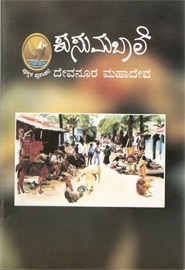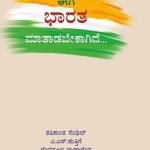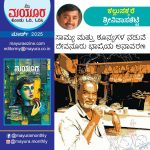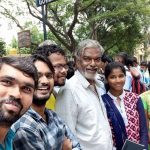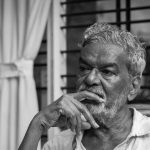A note on bakhtin’s semiotic theory – Kikkeri Narayan
[In this essay presented by Kikkeri Narayan at an international conference, ‘Kusumbale’ is analyzed keeping Bhaktin’s theory at the centre. ಕಿಕ್ಕೇರಿ ನಾರಾಯಣ ಅವರು ಅಂತಾರಾಷ್ಟ್ರೀಯ ಸಮಾವೇಶ ಒಂದರಲ್ಲಿ ಮಂಡಿಸಿದ ಈ ಪ್ರಬಂಧದಲ್ಲಿ ಭಕ್ತಿನ್ ಥಿಯರಿಯನ್ನು ಕೇಂದ್ರದಲ್ಲಿ ಇಟ್ಟುಕೊಂಡು ‘ಕುಸುಮಬಾಲೆ’ ಯನ್ನು ವಿಶ್ಲೇಷಿಸಲಾಗಿದೆ. ಆ ಲೇಖನ ನಮ್ಮ ಓದಿಗಾಗಿ …. ]
Russian formalism, in which contemporary structural analysis claims to have its source, stopped at a particular point when it encountered its own limitations, viz, EVERY THING IS STRUCTURED : SO WHAT ? Bakhtin’s work came as a powerful attempt to transcend this limitation. Bakhtin was one of the first to replace and give a jolt to the concept of viewing a literary text as a ‘static structure’. He replaced the concept of the text saying that the literary structure does not simply exist but is generated in relation to ‘Another Structure’. Unlike the early Propp, or many modem structuralists, Bakhtin never envisaged structure as transcendental or supreme. The authority of structure (political, narrative, and syntactic is socially constructed and historically changing. It is only in societies isolated from significant linguistic diversity, structure of narrative appear to have complete authority, the authority of myth. For Bakhtin, there is a decisive movement in the life of a speech community when it encounters a powerful language other than its own. Suddenly everything changes under the pressure of this new found heteroglosia / polyglossia.
Heteroglossia is an important term for Bakhtin. It is a key term for describing the complex stratification of language into genre, register, sociolect, dialect and mutual interanimation of these forms. In the book DISCOURSE IN THE NOVEL he demonstrates how language is stratified according to its social activity. It is stratified according to the professional usage of language. In the broad sense of the term ‘professional’ means the language of the lawyer, the doctor, the businessman, the politician. As regards caste language and geographical dialects in the Indian context (Pattanayak, D.P. ; 1975) Bakhtin calls this a case of heteroglossia.
Each social group of class stands in a different relation to the abstract system of the speech community in which it finds itself. Sociolects refer to the differential possession concretisation of the system by different groups which are defined by age, genre system, economic positionand kinship relation.
Bakhtin, who largely differed from Russian Formalism, also reacted sharply against Saussure’s ‘Objectivist’ Linguistics. Bakhtin shifted attention from the abstract system of `language’ to the concrete utterances of individuals in particular social contexts. The sign, for him, is a less fixed unit than an active component of speech as it was for Barthesit is Negation of Negation – modified and transferred in meaning by the variable social tones, valuations and connotations it condensed within itself in specific social condition. Since such valuations and connotations were constantly shifting, the ‘linguistic community’ was in fact a heterogeneous society composed of many conflicting interests. The sign for Bakhtin was less a neutral element in a given structure than a focus of struggle and contradiction. It was not simply a matter of asking ‘what the sign meant’, but of investigating its varied history of conflicting social groups, classes, individuals and discourses which sought to appropriate it and permeate it with their own meanings. Language for Bakhtin, was a field of ideological contention, not a monolithic system : indeed signs were the very material medium of ideology, since without them no values or ideas could exist. Bakhtin’s view of the ‘word’ as a dialogic construct, is based on the Russian term ‘slovo’ which means both ‘word’ and ‘discourse’- with the two being logically interchangeable. According to Bakhtin, ‘word’ is an extremely complex and many sided phenomenon (1973:150). Central to Bakhtin’s thinking is the idea that a word should not be relegated to lexical items alone, for it has in itself connotations derived from another ‘voice’. Therefore, two voices. This according to Bakhtin is ‘dialogical’, because it takes cognisance of another speaker’s word either prior to or at the very moment of utterances. So the notion of the word as ‘dialogic sign’ emphasizes the clear relationship between the sign, its sender, its receiver.
For Bakhtin, words were multi-accentual rather than frozen in meaning; they were always the words of one particular human subject for a specific other in a particular context which shapes their meaning. Bakhtin’s theory of language laid the foundation for a ‘materialist theory of consciousness’. Language neither ‘expression’, ‘reflection’ nor an abstract system, but rather it is a material body of the sign transformed through a process of social conflict and dialogue into meaning.
Bakhtin not only emphasised those differences between the forms used to convey meaning identity but also to differentiate social groups and context. He sees sociolects as constantly struggling to attract words and linguistic forms into their own robit inorder to re-infliect them fortheir own use. Words are inflected by a certain sociolect so as to impose upon them specific semantic nuances and specific axiological overtones. This sociolect can create slogan words, curse words and so forth. Bakhtin has shown how antagonistic classes like thieves, convicts, political terrorists systematically invert, negate and re-lexicalize the norm language. It is this area of linguistic combat, the ideological inter-animation between unmerged voices, from which dialogism emerges. For Bakhtin, heteroglossia is not simply a range of socio-linguistic variations, nor a kind of horizontal spread of dispersed speech forms. Because language is socially unequal, heteroglossia implies dialogic interaction in which the prestige languages try to extend their control and the sub-ordinated languages try to avoid, negotiate or subvert that control. Languages is not a neutral medium that passes freely and easily into the private property of the speaker’s intentions. Expropriating it, forcing it to submit to one’s own intentions and accents, is a difficult and complicated process. The word is not controlled solely by the speakers : it is half someone else’s (The dialogic Imagination).
All discourse, for Bakhtin lives on the boundary between its own context and an alien context. Every time it is uttered, a word is recontextualized.
The word, directed towards its object, enters a dialogically agitated and tension-filled environment of alien words, value judgements and accounts, weaves in and out of complex inter-relationships, merges with some, recoils from others, intersects with a third, all these socially shape discourse. This complicates its expression and influences its entire stylistic profile. This idea of language has been metaphorically expanded by Bakhtin to the analysis of the novel.
The novel, for Bakhtin, is more extensive genre than is normally conceived. He defines the novel as a diversity of social speech types and some times even a diversity of language and individual voices, organised in an artistic fashion.
In contrast, certain traditional genres such as the myth, the epic, and the tragedy are the products of a centralised tendency in language, a “mono-glassic absolutism”. This is why early structuralism works so well in analysing these genres, sealed off from heteroglossia. They are immune to an inter-textual’ interference. Structuralism, for Bakhtin tends to look towards monoglossia.
For Bakhtin, language is also spilt, conflict-ridden, dispersed and drastically heterogeneous. But it is also systematic, highly loaded patterned and regular. Both poles, the homogeneous and heterogeneous, operate to produce meaning, and from this dialectical perspective Bakhtincan analyse a whole range of speech events in their historical specificity. Only for those who identify language with the Saussurean concept of gangue’ it appears paradoxical. Saussure had excluded heteroglossia in his model by calling it ‘parole’, for it did not come in the purview of linguistic description.
Trained in classical philology, Bakhtin is aware of linguistic hybridization-the influencing and mixing of distinct language strains. He sees the birth of the modern narrative, like Don Quixote, as crucially determined by an active polyglossia, dialogic interaction between ‘high’ classical languages (chivalric romance, sermon, homily, idealist philosophies) and low’ vernaculars (anecdotes, street songs, folk sayings, the language of the street, the market place). It is this dialogic relation between high and low language acting upon each other that works in the making of a novel.
In the analysis of the modern novel, Bakhtin’s notion of polyglossia is of decisive importance. Julia Kristeva, together with writers of the once radical Tel Quel group in France, has emphasized the polyphonic qualities of major modernist fictions. Heteroglossia, in the context of verbal art, as Bakhtin defines it, is another’s speech in another’s language, serving to express authorial intentions in a refracted way. Such speech constitutes a special type of double-voiced discourse in which there is always present one voice and two meanings. Therefore it is al-ways internally dialogised. In other words, every word inheres, by virtue of its association with some ideological position, a social or political group. ‘no word belongs to any one’. This is ‘how Bakhtin’s theory becomes important in the production of the cultural text and critical theory. Bakhtin’s theory has opened avenues since the historically less concerned and alienated tendencies of structuralists and post-structuralists. Bakhtin’s explorations in this aesthetic and the formal contentions in literary/cultural debate have always been the expressions of actual social contentions within specific historical contexts.
II
I would like to see KUSUMA BALE: The Text, from the following points of view:
- concept of story:
- The concept of time or history used in the text in relation to the concept of ‘sign’ or word used by Bakhtin.
- Concept of myth in this text as diachronic and synchronic.
- Heteroglosic, dialogic and polylogic nature in the text.
- Music in this text.
- In ‘Kusumabhale’, the story is given in the beginning of the text itself. It runs as follows:
“The day after her husband’s, obsequies, Akkamaadevamma returns to her parents’ house. She gives birth to her child, Yada, twelve months, after her husband’s death, and the child is branded as the son of a bonded labourer. Six years later she goes back to her husband’s house to claim her portion of the property. But her brothers-in-law seize her and throw her out half dead on the grazing ground. And marvelously, the very ground where she is thrown takes the shape of the but which in time grows into a great and prosperous house, while the celebrated house of her brothers-in-law falls into ruins and becomes a shed for the cattle of Akkamadevamma’s family.
Now, the wealthy and influential Somappa, grandson of Mahadevamma, is the headman of the village, and the headman’s daughter is Kusumabale. Kusumabale so it happens, is in love with the untouchable Channa, and their relationship comes to light when she gives birth to a child, black like Channa. Soon Channa is murdered by her relatives, without the villagers coming to know of it.
At the same time, as the whole village is preparing for the fire-crossing festival, Kempi, a relative of Channa, struggles together with her mother Turamma to save her sick child from the forces of death. Meanwhile, a meeting and procession of the Dalith Sangha (a Union of Harijans) are held in the village, and Channa’s parents, unaware of his death, wait and wait for Channa to return.
The author gives the story of the text ‘Kusamabale’ right at the beginning. It would be curious to know why the other seventy seven pages of the text are written at all. The answer can be found in Bakhtin’s concept of the literary text. He situates the text within the history and society as he does the ‘word’. He then examines the text as read by the writer, into which he inserts himself and rewrites history and society. Diachrony is transferred into synchrony, and in the light of the transformation, linear history appears as an abstraction. The only way the writer can participate in history is by transgressing this abstraction through a process of reading-writing, i.e., through the practice of signifying structure in relation or opposition to another text. History and morality are written in the infrastructure of the texts. This is what Bakhtin calls ‘Cronotope’. The literary text, polyvalent and multidetermined, adheres to a logic whichreaches beyond that of a codified discourse into the margins of the recognized culture.
The archaic elements of the genre are preserved in a renewed form in the highest stages of the genre’s development, moreover, the higher the genre develops the more complex it becomes, the more fully it remembers its past (1973:99).
The reader of the first possible level, who reads the text for plot and events finds only one paragraph where the story has been told. The second possible reader, who reads for idealogy and for debates of ideas, may hardly find any logical and reasonable connections, because there is non-linkage and discontinuity in the physical progression of this text. The other possible reader, who reads this text as a fabric of other texts-intertexuality of myth, children’s stories, story of a myth, grandpa’s story, story of a visionary, a seer. This story is a dissemination of intertextual references from demi-gods to human beings and rationalists. The reader can form a new sign.
So the sign values in the text, the signifier and signified, are recontextualised and given a new sign value and thus produce a totally new sign out of above mentioned things. So, the story does not become very important, but the way in which it is told does. This text becomes important for the reasons given by Bakthin.
TIME AS INFINITIZED TOTALITY
The writer in the text ‘KUSUMABALE’ tries to write the history of the downtrodden community, which does not have any recorded history. The whole text is utilized to establish this.
Time in Kusumabale is not just a chronological order, it is the order of the myth, the history of the mind of the downtrodden castes, which have not written history. This cannot be represented in chronological time. That is why the author creates super-natural characters, the Jotammas. Jotammas belong to different families of different castes of that village.
The genesis of the family of Kusumabale upto Akkamahadevamma is narrated by the cot to Somappa, the father of Kusumabale not directly to him, but to his soul, after he goes to bed. The cot narrates not only its story, but the story of the king who had got it made, and recalls its past glory. To quote from the text “How many Rajas from how many kingdoms came to see me! indeed it is impossible to count how many came and went. Was there a speck of dirt on my body then?” etc.
“That was how I lived. But if misfortune strikes, what a plight one can suffer (to)” etc., because the cot was auctioned and bought by Yada, the father of Somappa. The cot not only talks about itself, but also talks quite a lot about kings and their misfortunes. It also narrates the chronological history of Kusuma Bale’s lineage, the history of the dynasty and the history of the family. The author uses the techniques of the dolls which narrate the story of Vikramaditya. Thus it is a sort of condensed echo of interminable chronologies, but every sequence is recovered time. The subsequent sequence emerges out of chronology and forms an entirely different time. What moves along quickly are the perpetually divisible episodes.
Amidst this, the history of the present is also taken into account, the story of the down-trodden, the story of a thief, the story of a group of progressives and Marxists, harijans-both educated and uneducated, caste and class struggle and the story of a feudal lord, Somappa.
Thus various kinds of ‘time’, mythological, psychic, and historical confront and converge into one single time, which is ‘present’. But once again time is shattered by Kuriyayya, an age-old man, who narrates the story of the history of their caste to the young harijan rebels. Here once again the writer takes up a folk story about the origin of the caste system. The reactions of the group are noteworthy.
“The leaders of the sangha, including B.Krishnappa, had become babies, crying and babbling ‘lovvo-lovvo’ for their mother’s breast milk”. To a revolutionary doctor, Kuriyayya, looks like a C.I.A. agent ‘blood boils to someone else; another fellow touches his feet and salutes, etc.
Kuriyayya becomes possessed by ‘toreajoammas’, the caste’s family diety and speaks like a rshi-a seer- who knows the whole truth, that which happened in prehistoric time even before the origin of the caste system. Thus, history of time in twentieth century becomes more complex. Thus it reflects the history of philosophy, history of mind, history of caste and class struggles. There it no single specific history. What emerges is a heterogenous, poly-logic, poly-temporal history. Thus it has ‘multiple voices’. The reader is made to re-fashion within his own semiotic processes, the specific temporalities of those voices. Thus there is no other choice for the writer except writing the polylogic, polytemporal complex history of the people belonging to the caste or class of which there is no written history. This is how the subject of four thousand or more years of history of this country is rewritten. In this manner the text Kusumabale is a new phenomenon in the history of Kannada literature. The past is not opposed in the present, nor to the future, ‘Time is not even cyclic: all time is merged’.
Naturally, the language used in this text changes according tothe situations. Though it seems that the writer uses the Harijan dialect of Mysore district, basically he makes use of the language of mythology, history, the language of folk songs and folk literature, the language of the educated people, language of Marxists, and the language of illiterates. A Brahmin character speaks not in a Brahmin dialect, but in the Harijan dialect with Sanskrit ‘visarga’ suffixed at the end of each word. English words are used. These words do not appear as they are but are re-lexicalised in their contexts. Here is the area of linguistic combat, the ideological inter-animation of un-merged voices, which focuses on dialogism. Heteroglossia here implies dialogic interaction. This is how the text is born from interanimation, the intermixing of language images and thus becomes inter-textual also.
VOICE OF THE DUMB
The murder of Channa, Kusumabale’s lover is signified by the non coordination of two different castes, the Lingayat and the Harijan the product of their love, the child, is not talked about throughtout the text. The child remains silent throughout, signifying the dumbness of society.
Kusumabale, the main character of the novel also remains dumb throughout the novel, except at the end. She remains in the background and speaks out loudly clearly the message of the down trodden women in our society.
MYTH—INTERIOR AND EXTERIOR
(“For it is human history which conveys reality into speech, and it alone rules the life and death of mythical language. Ancient or not, mythology can only have an ‘historical foundation’, for myth is a type chosen from the nature of things.”
-R. Barthes Mythologies)
Myth in this text is used to exteriorise the interior, sub-conscious mind of the community, whereas the exterior, the real happenings, are interiorised in the mind of the public. For example, the mysterious murder of Channa, the Kusumabale’s lover becomes mythified.
Kusumabale’s contact with Channa, and their child being rejected, are exteriorized by mythical characters. Later the murder of Channa is also revealed through these characters.
Though the murder of Channa is mythified through the people of the village they still believe that Channa is alive and comes back to see them all.
Mahatma Gandhi is a mythical character rather than a historical one:
“I do know, it seems that in the past there was someone by the name Mahatma Gandhi, the way that the little fellow used to pester was becoming unbearable even to the whiteskins. So those whiteskins used to keep on catching him, and they kept on shutting him up in jail in the mosquito-cell and this and that, it seems with a lock that no one can open, and even then out little fellow caked Gandhi, by what magic and I do not know, if he was locked on this side, he would escape on that side, smiling, and he kept on coming out again adjusting his ‘tope (cap). Ah! That Mahatma Gandhi !
Similarly Indira Gandhi becomes a myth: she prepares her tea by burning hundred rupee notes. Thus there is a myth-making and myth—breaking quality in the text. Myth has been given momentum. This text does not allow monoglossia. Monoglossia, according to Bakthin, is not possible in a stratified society. Thus the text is not a ‘static structure’ but is generated in relation to another structure.’
MUSIC OF THE TEXT
With odd punctuations, Kusumabale is not a sentence, but more than that. The sentences are sometimes incomplete, but their significance in the context of the text can easily be re-stored. The clauses and the sentences can easily be isolated and punctuated. But in doing so, the reader loses the logical, semantic and syntactic ambiguities and also certainly the music. Kusumabale does not allow the reader to read with his/her mouth shut. The reader is volitionally made to read aloud in order to feel the music of the language, that is the intonation and rhythm. Music in every day language, which works subordinate to language, here super -ordinates. Sometimes half – written sentences are found, but meaning and significance are very much there. The semiotic process does not stop there, for they can easily be restored. Thus the sentence- meaning significances here act as its lower limit. The instinctual drive across the boundary exerts its full impact, thus situates the semiotic experience beyond the physical divisions of the text and goes beyond semantic signification and meaning. The folk music reverberates in the mind of the reader and goes beyond linguistic reasoning. Some sentences, though left unfinished, but they set up associative chains and bonds with each other. The intonation rises and falls rhythmically and goes beyond the succession of “The eye cannot be excluded by the ear, sounds become images invocative instrumental drive, encounters the signifiable realistic polylogical object. This is not the music poetry. In this narrative, the syntactically normative sentence develops within the context of prosaic and poetic, historical and mythological narrations.
So we have here a heteroglossic, dialogic and translinguistic text. It gets significance only when it is read as story of intertextuality.
Select bibliography
- Bakhtin, Mikhail1968 Rabalais and His World, Helene Jswolsky. Trans. Cambridge MIT Press.
- 1973 Problems of Dostoevesky’s Poetics, R.W.Rostel, trans. Ann Arbor: Ardis.
- 1982 The Dialogic Imagination: Four Essays by M.N.Bakhtin. Michael Holquist. Ed.
- Cary Emerson and Michael Holquist: trans. Austin: University of Texas Press.
- Derrida, Jacques (1974) of Grammatology. Trasl. G.C. Spivak John Hopkins University Press, Baltimore.
- Glowersmith Frank. F. 1984: The Theory of Reading. The harvest Press Limited, Brighton, Success.
- Kristeva, Julia, 1980: Desire in Language; A Semiotic Approach to Literature and Art, ed. Thomal Gora, Alice Jardine and Leon S. Rondiez. Trans. New York: Colombia Uni. Press.
- Pattanyak D.P.: (1975) ‘Caste and Language’ IJDL Vol. IV No.2.
*****
